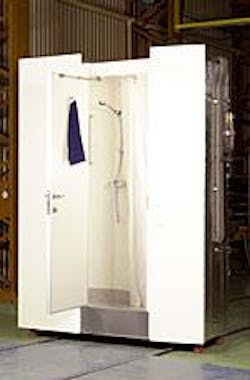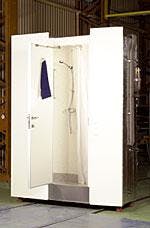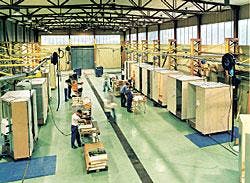Wet unit market expands as IMO standards come into force
Premec Industries specializes in pre-fabricated wet units for offshore accomm- odation modules, ships, and other marine installations. It manufactures both stand-ardized and customized wet units ready for installation onboard. Water supply, sanitation, electricity, and ventilation are connected outside the wet-room, which shortens installation time.
Premec has built more than 1,200 rooms per year. Since 1995, the company has produced wet units for various segments of the marine industries. It produces wet units both for newbuildings and for retrofit. Its wet units are featured on the new Gorilla-class jackups for Rowan Drilling.
New markets continue to open for the company. Recent work has included contracts for West Africa, Turkey, Caspian Sea, and many places in the Far East, including China, Vietnam, Thailand, Indonesia, and Australia.
Wet units can be delivered completely assembled to the shipyard for direct installation or as "flat-packs" for retrofitting. All rooms are individually checked, and all the lines are pressure tested before shipment.
Wet unit walls with a sandwich construction use galvanized steel or aluminum walls covered with PVC, Perginol, or tile coating depending on the facility and requirements. Insulation between the steel walls provides sound damping and fire protection. Covering exposed insulation and pipes with aluminum provides dust protection. Both single and dual-flush capability are available for the wet unit toilets. Measures have been introduced to reduce vibration-induced noise through use of a specially designed installation system.
Increased retrofit market
The company has been very active in the refurbishment market offshore. Both the North Sea and Gulf of Mexico are seeing older installations upgraded and refurbished with new rooms.
One of the drivers for this activity is the need for better safety and fire protection. The new International Maritime Organization IMO 754 regulations, instituted last year by the IMO, put pressure on many shipyards because they could not meet the new requirements. Many of the new regulations apply to self-propelled vessels as well as dynamically positioned rigs. This has opened new opportunities for specialty producers like Premec which are used to working to exacting standards.
Over the past few years, there has been an increase in demand in the offshore oil industry and the refurbishment market has been strong. Premec refurbished the wet units for the Statfjord platform in the North Sea, which is undergoing a multi-year upgrading. In the US, the company refurbished the wet units for a semisubmersible, bringing it up to IMO 750 standard for its new production role.
Last year, the company completed a number of refurbishment projects including:
- 45 units for a multi-service vessel
- 38 units for a drilling rig
- 12 units for a field in the Dutch North Sea
- 70 units for a derrick barge
- 30 units for three jackups, which were all fitted with new showers, floors, and ceilings.
The refurbishment market is expected to continue to grow. Many new interior designs include wet-rooms with individual cabins rather than the 'gang-style' wet units of earlier vessels. The dwindling numbers of experienced marine oilfield workers are also demanding more comfort.
New construction has continued strong as well. The company delivered wet-rooms to a number of projects over the past year including:
- 117 units to a Norwegian field platform
- 79 units for Caspian Sea projects
- 70 units to an operator
- 64 units to a drilling semi.
Reduced installation time
A contract for a field in the North Sea required a new type of wet-room. In most situations, the rooms are shipped without an exterior lining. This is normally added to the units once they are installed in the yard. For Grane, the exterior lining was added to all the steel units to reduce costs and assure good quality control at the factory. It also cut installation time in the yard.
To address this growing need for wet units, Premec shortened its lead times and improved its productivity 100%. Five years ago, construction time averaged 10 to 12 weeks from when the final drawings were approved, but now wet-units can be delivered within six weeks. This productivity improvement was possible because customers accepted standardized units and order timing was fine-tuned with suppliers, resulting in just-in-time deliveries.
For more information, contact Ann-Britt Trogen, Premec. Tel: +46 534 618 00, fax: +46 534 617 11, email: [email protected].
null


